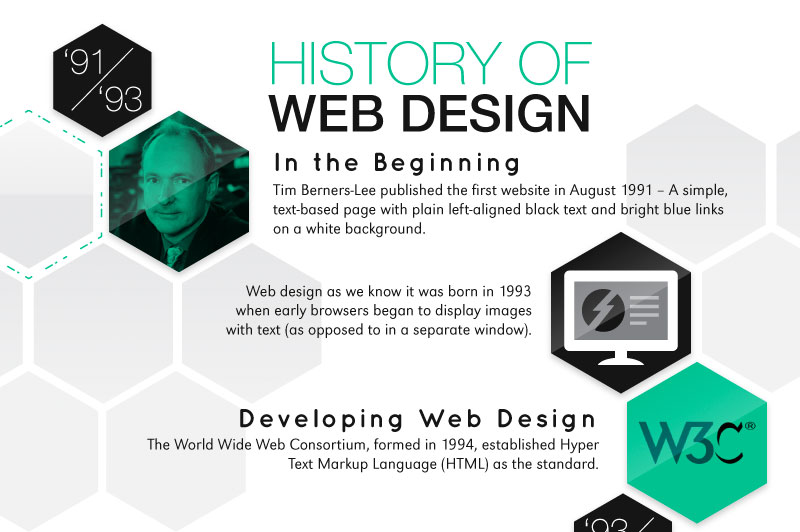Join Us As We Embark On A Trip Through Time, Exploring The Advancement Of Site Layout And How It Has Influenced The Electronic Landscape
Join Us As We Embark On A Trip Through Time, Exploring The Advancement Of Site Layout And How It Has Influenced The Electronic Landscape
Blog Article
Write-Up Created By-Solis Wren
In the past, sites were easy and concentrated on information. Navigating was direct, and layout was for desktop computers. Currently, user experience is key. Information guides layouts for easy navigating. https://www.searchenginejournal.com/on-page-seo/image-optimization/ match various gadgets. Today, dark mode decreases stress, and minimal food selections boost navigating. Interactive features engage users, and bold visuals stand apart. AI combination enhances interaction. See exactly how design has progressed to enhance your on-line trip.
Very Early Days of Website Design
In the early days of website design, simpleness preponderated. Sites were basic, with restricted colors, fonts, and formats. The emphasis got on providing details instead of flashy visuals. Customers accessed the web with sluggish dial-up links, so rate and capability were vital.
Navigation food selections were straightforward, usually located at the top or side of the web page. Sites were developed for desktop computers, as mobile surfing had not been yet widespread. Content was king, and designers prioritized simple readability over complicated layout aspects.
HTML was the primary coding language used, and designers needed to function within its restraints. Animations and interactive functions were very little compared to today's standards. Sites were fixed, with little vibrant web content or personalized customer experiences.
Surge of User-Focused Design
With the evolution of internet site layout, a shift in the direction of user-focused layout principles has become increasingly noticeable. Today, creating internet sites that prioritize individual experience is crucial for engaging visitors and achieving organization objectives. User-focused design entails comprehending the needs, preferences, and actions of your target audience to customize the site's layout, content, and features accordingly.
Designers now conduct detailed research study, such as customer studies and usability screening, to gather insights and feedback straight from individuals. This data-driven strategy assists in developing user-friendly navigation, clear calls-to-action, and aesthetically attractive user interfaces that reverberate with visitors. By positioning the user at the facility of the design procedure, websites can provide a more customized and enjoyable experience.
Receptive style has actually also become an essential facet of user-focused style, making sure that sites are optimized for numerous devices and screen dimensions. This versatility improves accessibility and functionality, satisfying the diverse methods users interact with internet sites today. Fundamentally, the rise of user-focused style represents a change towards creating electronic experiences that prioritize the needs and expectations of the end customer.
Modern Trends in Website Design
Discover the latest trends shaping website design today. One popular pattern is dark mode style, supplying a streamlined and modern appearance while minimizing eye strain in low-light settings. One more crucial pattern is minimalist navigating, streamlining food selections and enhancing customer experience by focusing on essential elements. Incorporating micro-interactions, such as computer animated switches or scrolling results, can produce a more engaging and interactive web site. website home page content remains crucial, making certain smooth customer experiences throughout numerous gadgets. Furthermore, using strong typography and asymmetrical designs can add aesthetic interest and draw attention to certain content.
Integrating AI technology, like chatbots for consumer assistance or individualized suggestions, improves individual engagement and simplifies processes. Ease of access has likewise end up being a substantial pattern, with designers prioritizing inclusive design techniques to cater to varied individual demands. Accepting sustainability by enhancing internet site performance for rate and performance is an additional emerging trend in website design. Teaming up with user comments and data analytics to iterate and boost design constantly is necessary for remaining relevant in the ever-evolving digital landscape. By embracing https://seoconsultingservices05050.blog4youth.com/30432665/boost-the-efficiency-of-your-website-by-utilizing-on-page-seo-strategies-that-improve-your-on-line-visibility-and-engage-your-target-market , you can develop a visually appealing, straightforward web site that reverberates with your audience.
Conclusion
As you reflect on the advancement of site design from the early days to now, you can see just how user-focused design has actually come to be the driving pressure behind contemporary fads.
Accept the trip of modification and adaptation in website design, always keeping the user experience at the leading edge.
Keep current with the most up to date fads and technologies, and never stop evolving your technique to create visually stunning and straightforward internet sites.
Develop, adjust, and develop - the future of web design is in your hands.
